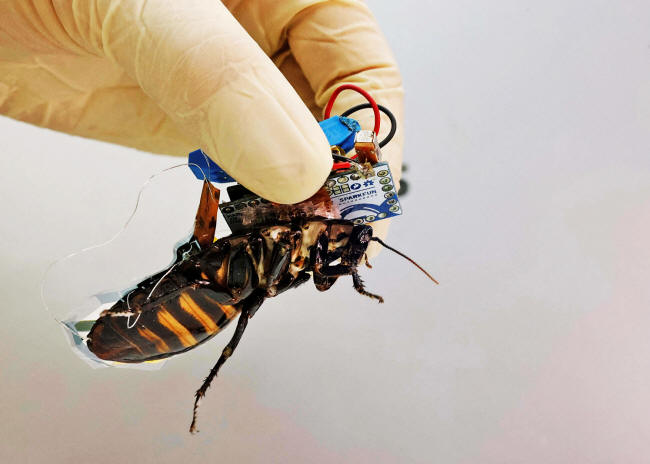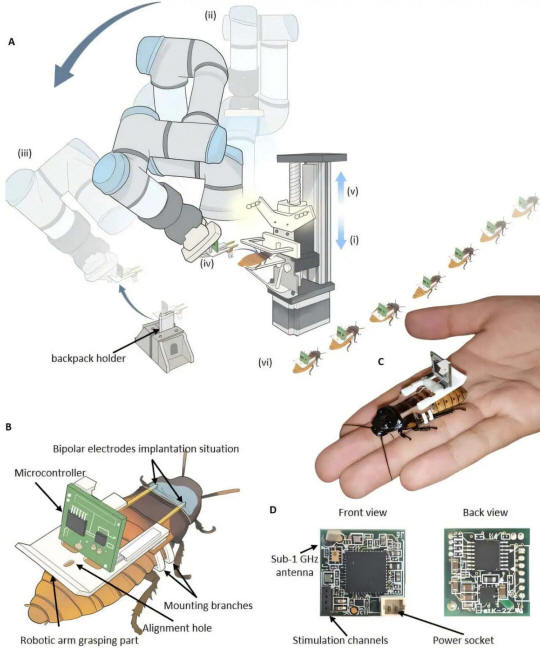|

by Tibi Puiuby
December 18, 2024
from
ZMEScience Website

A researcher shows a Madagascar
hissing cockroach,
mounted with a
"backpack" of electronics and a solar cell
that enable
remote control of its movement.
This is part of
a previous effort from 2022
by researchers
in Japan.
Similar cyborg-roaches
have been demonstrated
by research
labs across the world.
Credit:
REUTERS/Kim Kyung-Hoon
The new system
can turn cockroaches into
cyborgs
in under 70 seconds.
In a lab in Singapore, robots are hard at work:
not on cars or gadgets, but on cockroaches.
Grab a chair, you might want to sit down for this
one...
This work is part of a breakthrough system designed to convert
living insects into "cyborgs," combining biology with engineering in
a process that's faster, more efficient, and eerily precise
I'm talking about what essentially amounts to a
factory of insect cyborgs.
The goal...?
To turn one of the world's most resilient
creatures into an invaluable tool for navigating disaster
zones...
Madagascar hissing cockroaches (Gromphadorhina
portentosa), famed for their toughness, take center
stage.
Researchers at Nanyang Technological
University have automated the delicate process of equipping
these arthropods with tiny electronic backpacks, reducing assembly
time from 30 minutes to just 68 seconds.
Dubbed the "Cyborg
Insect Factory," the system uses a robotic arm guided by
a type
of AI known as
deep learning to implant
control mechanisms that steer the insects via antenna stimulation.
"We're laying the foundation for scalable
production and deployment in real-world applications," the
researchers wrote in their preprint study on
arXiv.
(Cyborg Insect Factory - Automatic Assembly System to Build
up Insect-computer Hybrid Robot based on Vision-guided Robotic
Arm Manipulation of Custom Bipolar Electrodes)
The Cyborg Insect Factory

Diagram showing how
the insects are
attached to the electrodes
creating a
hybrid robot
Insect-computer hybrid robot
and its
automatic assembly setup.
Credit: arXiv
(2024).
Insect-computer hybrids, sometimes called biobots,
have been the subject of research for years.
The idea is simple:
harness the natural mobility of insects and
augment it with robotic control systems.
Unlike fully mechanical robots, these hybrids
don't need complicated motors or large power supplies:
they use the insects' own legs and energy...
Cockroaches might not be the most beloved
creatures, but their biology makes them ideal for this kind of work.
Agile, lightweight, and capable of traversing
complex terrain, they outperform even the most advanced
biomimetic robots. Their natural resilience is complemented by
their electronic upgrades, allowing precise remote control and even
speed adjustments.
But, until now, creating these cyborg insects required
delicate and time-consuming manual work.
"The outcome of the surgery was highly
influenced by the human's operation," the researchers wrote.
This inconsistency made mass production
impractical.
The new method pioneered in Singapore changes that.
Using a robotic arm, a vision-guided system,
and a set of tiny electrodes, the team can assemble a cyborg
cockroach in just 68 seconds.
The electrodes are implanted between the
insect's
pronotum (the plate
covering its thorax) and its
mesothorax, which is near
the cockroach's nerve pathways that control its legs.
When the electrodes receive electrical
pulses, they stimulate these nerves.
Each cyborg cockroach is equipped with a
lightweight backpack containing a communication system and
electrical stimulators.
A small jolt to one antenna directs the insect
left; another sends it scurrying right. These particular roaches,
Gromphadorhina portentosa, have an added quirk:
they hiss...
By forcing air through tiny openings called
spiracles, they produce sounds that can signal aggression or
disturbance.
It's a dramatic touch to a creature that's
already upending expectations.
How It Works
The process starts by gently fixing the anesthetized cockroach in
place and exposing the target area.
A deep-learning algorithm then guides
the robotic arm to precisely implant the electrodes.
The electrodes are custom-designed to
puncture the membrane and hook securely in place.
The robotic arm's precision is of the utmost importance.
Even slight variations in electrode placement
could affect the cockroach's response.
By automating the process, the team eliminated
these inconsistencies, ensuring each cyborg
insect behaved predictably.
Tests showed the automatically assembled cyborgs
performed just as well as those assembled by hand.
They could turn left or right with angles of
up to 80 degrees and decelerate by over 60 percent.
In a field trial, a team of four cyborg
cockroaches successfully navigated a small, obstacle-filled outdoor
area, covering 80 percent of the terrain in just over ten minutes.
While the electrical pulses can direct the cockroach to turn or slow
down, these commands don't completely strip the insect of its
autonomy.
The cockroach's own sensory system is still
active, and it can respond to environmental cues.
For example,
if an obstacle appears in its path, the
cockroach may still try to navigate around it naturally.
This partial control means the
hybrid insects are not mindless robots - they are more like
guided agents, blending the adaptability of living organisms
with the precision of robotic systems.
So, the electrodes act like suggestions rather
than absolute commands, nudging the cockroach in a specific
direction.
Automating the process opens the door to producing hundreds or even
thousands of these hybrid creatures for missions like locating
survivors in collapsed buildings or exploring hazardous
environments.
But the work isn't done yet.
While these cyborgs can be steered remotely,
managing swarms of them simultaneously remains a challenge.
The researchers envision a future where such
armies operate autonomously, requiring little human intervention.
A Step Towards Swarm Robotics
The concept of cyborg insects has sparked mixed
reactions, ranging from amazement to unease.
Some see them as a cutting-edge tool for
disaster response, while others wrestle with the ethics of
merging biology with technology.
However, there are potential upsides to swarm
robotics.
In a disaster scenario, dozens or even hundreds of these hybrid
insects could be deployed to search through rubble, using their
natural ability to squeeze through tight spaces.
Other potential uses include,
inspecting hard-to-reach areas in factories
or exploring hazardous environments like collapsed mines.
The researchers believe their method lays the
groundwork for,
"scalable production and deployment in
real-world applications."
Still, ethical questions remain.
As with any technology involving living
organisms, the welfare of the insects is a concern. The team used
anesthesia to minimize discomfort during the assembly process, but
long-term impacts are less clear.
There's also the question of control:
how much autonomy should these cyborg
insects have, and what safeguards are needed...?
|



